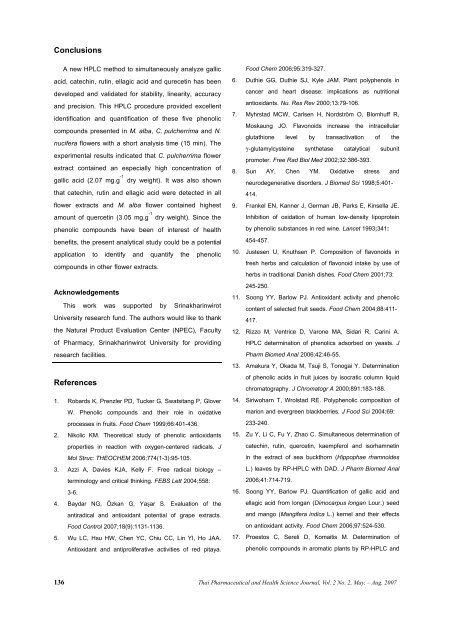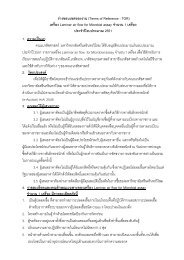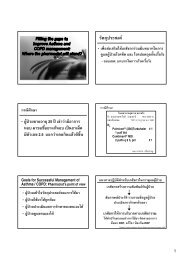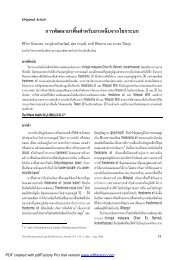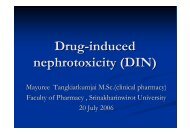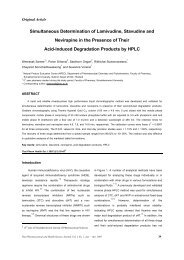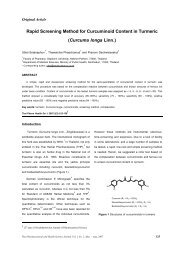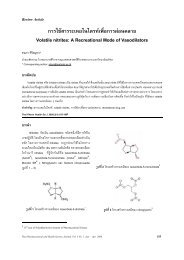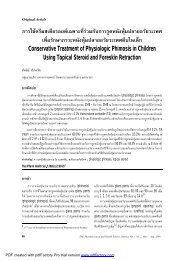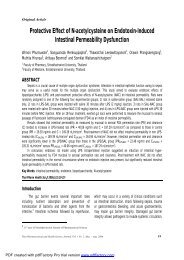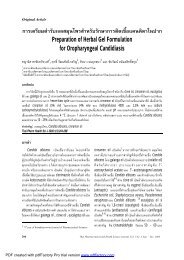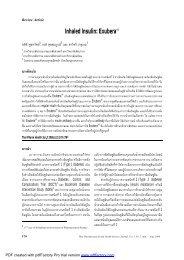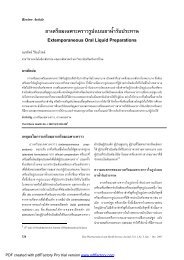Simultaneous Determination of Gallic acid, Catechin, Rutin, Ellagic ...
Simultaneous Determination of Gallic acid, Catechin, Rutin, Ellagic ...
Simultaneous Determination of Gallic acid, Catechin, Rutin, Ellagic ...
You also want an ePaper? Increase the reach of your titles
YUMPU automatically turns print PDFs into web optimized ePapers that Google loves.
Conclusions<br />
A new HPLC method to simultaneously analyze gallic<br />
<strong>acid</strong>, catechin, rutin, ellagic <strong>acid</strong> and qurecetin has been<br />
developed and validated for stability, linearity, accuracy<br />
and precision. This HPLC procedure provided excellent<br />
identification and quantification <strong>of</strong> these five phenolic<br />
compounds presented in M. alba, C. pulcherrima and N.<br />
nucifera flowers with a short analysis time (15 min). The<br />
experimental results indicated that C. pulcherrima flower<br />
extract contained an especially high concentration <strong>of</strong><br />
gallic <strong>acid</strong> (2.07 mg.g -1 dry weight). It was also shown<br />
that catechin, rutin and ellagic <strong>acid</strong> were detected in all<br />
flower extracts and M. alba flower contained highest<br />
amount <strong>of</strong> quercetin (3.05 mg.g -1 dry weight). Since the<br />
phenolic compounds have been <strong>of</strong> interest <strong>of</strong> health<br />
benefits, the present analytical study could be a potential<br />
application to identify and quantify the phenolic<br />
compounds in other flower extracts.<br />
Acknowledgements<br />
This work was supported by Srinakharinwirot<br />
University research fund. The authors would like to thank<br />
the Natural Product Evaluation Center (NPEC), Faculty<br />
<strong>of</strong> Pharmacy, Srinakharinwirot University for providing<br />
research facilities.<br />
References<br />
1. Robards K, Prenzler PD, Tucker G, Swatsitang P, Glover<br />
W. Phenolic compounds and their role in oxidative<br />
processes in fruits. Food Chem 1999;66:401-436.<br />
2. Nikolic KM. Theoretical study <strong>of</strong> phenolic antioxidants<br />
properties in reaction with oxygen-centered radicals. J<br />
Mol Struc: THEOCHEM 2006;774(1-3):95-105.<br />
3. Azzi A, Davies KJA, Kelly F. Free radical biology –<br />
terminology and critical thinking. FEBS Lett 2004;558:<br />
3-6.<br />
4. Baydar NG, Özkan G, Yaşar S. Evaluation <strong>of</strong> the<br />
antiradical and antioxidant potential <strong>of</strong> grape extracts.<br />
Food Control 2007;18(9):1131-1136.<br />
5. Wu LC, Hsu HW, Chen YC, Chiu CC, Lin YI, Ho JAA.<br />
Antioxidant and antiproliferative activities <strong>of</strong> red pitaya.<br />
Food Chem 2006;95:319-327.<br />
6. Duthie GG, Duthie SJ, Kyle JAM. Plant polyphenols in<br />
cancer and heart disease: implications as nutritional<br />
antioxidants. Nu. Res Rev 2000;13:79-106.<br />
7. Myhrstad MCW, Carlsen H, Nordström O, Blomhuff R,<br />
Moskaung JO. Flavonoids increase the intracellular<br />
glutathione level by transactivation <strong>of</strong> the<br />
γ-glutamylcysteine synthetase catalytical subunit<br />
promoter. Free Rad Biol Med 2002;32:386-393.<br />
8. Sun AY, Chen YM. Oxidative stress and<br />
neurodegenerative disorders. J Biomed Sci 1998;5:401-<br />
414.<br />
9. Frankel EN, Kanner J, German JB, Parks E, Kinsella JE.<br />
Inhibition <strong>of</strong> oxidation <strong>of</strong> human low-density lipoprotein<br />
by phenolic substances in red wine. Lancet 1993;341:<br />
454-457.<br />
10. Justesen U, Knuthsen P. Composition <strong>of</strong> flavonoids in<br />
fresh herbs and calculation <strong>of</strong> flavonoid intake by use <strong>of</strong><br />
herbs in traditional Danish dishes. Food Chem 2001;73:<br />
245-250.<br />
11. Soong YY, Barlow PJ. Antioxidant activity and phenolic<br />
content <strong>of</strong> selected fruit seeds. Food Chem 2004;88:411-<br />
417.<br />
12. Rizzo M, Ventrice D, Varone MA, Sidari R, Carini A.<br />
HPLC determination <strong>of</strong> phenolics adsorbed on yeasts. J<br />
Pharm Biomed Anal 2006;42:46-55.<br />
13. Amakura Y, Okada M, Tsuji S, Tonogai Y. <strong>Determination</strong><br />
<strong>of</strong> phenolic <strong>acid</strong>s in fruit juices by isocratic column liquid<br />
chromatography. J Chromatogr A 2000;891:183-188.<br />
14. Siriwoharn T, Wrolstad RE. Polyphenolic composition <strong>of</strong><br />
marion and evergreen blackberries. J Food Sci 2004;69:<br />
233-240.<br />
15. Zu Y, Li C, Fu Y, Zhao C. <strong>Simultaneous</strong> determination <strong>of</strong><br />
catechin, rutin, quercetin, kaempferol and isorhamnetin<br />
in the extract <strong>of</strong> sea buckthorn (Hippophae rhamnoides<br />
L.) leaves by RP-HPLC with DAD. J Pharm Biomed Anal<br />
2006;41:714-719.<br />
16. Soong YY, Barlow PJ. Quantification <strong>of</strong> gallic <strong>acid</strong> and<br />
ellagic <strong>acid</strong> from longan (Dimocarpus longan Lour.) seed<br />
and mango (Mangifera indica L.) kernel and their effects<br />
on antioxidant activity. Food Chem 2006;97:524-530.<br />
17. Proestos C, Sereli D, Komaitis M. <strong>Determination</strong> <strong>of</strong><br />
phenolic compounds in aromatic plants by RP-HPLC and<br />
136 Thai Pharmaceutical and Health Science Journal, Vol. 2 No. 2, May. – Aug. 2007


